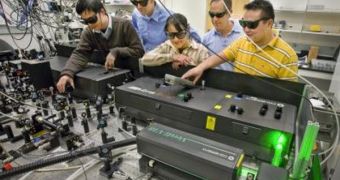Being able to assess the health of an organism starting from a cellular level has been one of the long-standing dreams in medicine and health care, and it would appear that good things do happen to those who wait (or do serious research instead). After years of study, experts at the US Department of Energy (DOE) Lawrence Berkeley National Laboratory (LBNL) have finally managed to create bright, stable and bio-friendly nanocrystals, which act like individual investigators inside single cells. They are able to emit various types of light, depending on the chemicals and processes they encounter inside the body, which makes them very reliable and useful.
Despite its size, the human (or animal) cell is a highly complex and perfectly evolved machine, able to host a vast array of chemical and biological processes. The new nanocrystal probes have the ability to analyze, for example, the activity of proteins inside this complex organism, which could help geneticists in a wide array of studies dedicated to this aspect of our lives.
Tracking down these tiny molecules using conventional equipment can trigger a host of issues, including massive amounts of laser excitation (which can ultimately destroy the probe), and competing lights coming from the probe and the cell itself. The new particles promise to overcome these issues.
“The nanoparticles we've designed can be used to study biomolecules one at a time. These single-molecule probes will allow us to track proteins in a cell or around its surface, and to look for changes in activity when we add drugs or other bioactive compounds,” LBNL Molecular Foundry Biological Nanostructures Facility staff scientist Bruce Cohen explains.
The new nanocrystals contain rare earth elements, which allow them to absorb near-infrared light, and to convert it to visible light, through a series of energy-transfer processes. The transfer appears only when the probe is constantly lit by a continuous-wave, near-infrared laser, as the system that the LBNL team has already set up.
“Rare earths have been known to show phosphorescent behavior, like how the old-style television screen glows green after you shut it off. These nanocrystals draw on this property, and are a million times more efficient than traditional dyes. No probe with ideal single-molecule imaging properties had been identified to date – our results show a single nanocrystal is stable and bright enough that you can go out to lunch, come back, and the intensity remains constant,” Imaging and Manipulation of Nanostructures center staff scientist Jim Schuck, who has also contributed to the investigation, adds.
“While these types of particles have existed in one form or another for some time, our discovery of the unprecedented 'single-molecule' properties these individual nanocrystals possess opens a wide range of applications that were previously inaccessible,” Schuck concludes. A paper detailing the find, entitled “Non-blinking and photostable upconverted luminescence from single lanthanide-doped nanocrystals,” appears in the latest issue of the journal Proceedings of the National Academy of Science.

 14 DAY TRIAL //
14 DAY TRIAL //